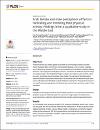Arab female and male perceptions of factors facilitating and inhibiting their physical activity: Findings from a qualitative study in the Middle East
التاريخ
2018-07-01المؤلف
Donnelly, T.Donnelly, Tam Truong
Mohammed Al-Thani, Al Anoud bint
Benjamin, Kathleen
Al-Khater, Al Hareth
Fung, Tak Shing
Ahmedna, Mohamed
Welch, Ailsa
...show more authors ...show less authors
البيانات الوصفية
عرض كامل للتسجيلةالملخص
© 2018 Donnelly et al. This is an open access article distributed under the terms of the Creative Commons Attribution License, which permits unrestricted use, distribution, and reproduction in any medium, provided the original author and source are credited. Objectives Physical inactivity is a leading global risk to health by contributing to obesity and other chronic diseases. Many chronic non-communicable diseases, such as cancer, diabetes, and cardiovascular diseases (CVDs), can be prevented and controlled by modifying lifestyle behaviors such as physical activity [PA]. However, prevalence of insufficient physical activity and obesity is high in the Middle East Region. In Qatar, the incidence rates of CVDs, diabetes, colon, and breast cancer have been rising rapidly. The purpose of this study was to explore facilitators and barriers influencing PA of adult Arab men and women living in Qatar and to understand what they think would be helpful to increase PA. The goal of the research is to identify culturally appropriate and effective interventions that improve the health of Arab population. Design Using the socioecological model as the theoretical framework, we conducted an exploratory qualitative study with 128 Arab adult men and women living in Qatar. We utilized focus group interviews to collect the data and performed thematic analysis to generate themes. Results At the individual level, perceived benefits of PA, presence of diseases, person’s will, motivation and goals, and time to exercise influenced the individual’s PA. At the sociocultural level, religious teachings of Islam, cultural, attitude, beliefs, and practices, and informal support influenced the participants’ PA. At the organizational and political level, physical environment to exercise, accessibility of facilities, organizational support, and health information about PA influenced their PA. Conclusion Arab men and women are aware of the importance and benefits of PA. They have the motivation to be physically active, but in the absence of supportive environment, their knowledge might not translate into action. Creating supportive environments at multiple levels that are conducive to PA is warranted.
معرّف المصادر الموحد
https://www.scopus.com/inward/record.uri?partnerID=HzOxMe3b&scp=85050022634&origin=inwardالمجموعات
- التغذية البشرية [458 items ]


